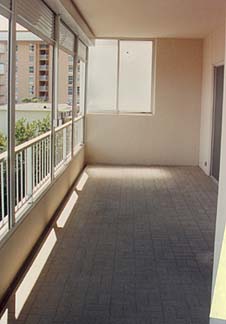

KEN IGE / KIGE@STARBULLETIN.COM
Joe O'Neill, above, of Hawaii Antique Center, has the head-turning piece behind him in the display window of his Kapahulu store. Carved from nara from the Philippines, a hardwood from the acacia family, it has a grain similar to koa, O'Neill said. Graceful silhouettes of torch ginger, bird of paradise and anthurium make up the motif, with rattan for its base."You can see through it, so it doesn't give complete privacy, but it makes a great backdrop for a Hawaiiana look." The $1,800 screen was inspired by craftsmen from the '30s and '40s like Fritz Alpenalp, a Swiss carver known for his work for Gumps of San Francisco and Waikiki during that time period.
Adding one more space-snatching object to your home to create more space defies logic, but that is what a divider screen does. It tricks the mind and fools the eye. Now you see clutter; now you don't. One room? Voila! Now, two.
Placing screen panels in a room
adds a splash of visual pizzazzBy Ruby Mata-Viti
rmataviti@starbulletin.com
Dividers can be purely utilitarian, used to camouflage unattractive window views, separate a work area or create an entryway that guides guests into a living room. They also can be decorative as a backdrop for a couch or, depending on size, a wall hanging.
COURTESY CHIASSO
From the Chiasso mail-order catalog, this screen offers sophistication with a modern feel, in a "glamorous rendition of a classic '50s design," the catalog says. Made of maple veneer, it sells for $850; shipping to Hawaii costs about $50. This is from last season's catalog, so quantities are limited. Order online at www.chiasso.com or call 1-800-654-3570.
Most of us are familiar with the typical three-panel shoji or the intricately carved Indonesian screens, but an unassuming three panels of plywood can go from boring to beautiful and be quite the problem-solver in the right hands.
For those fumbling with ideas, here are some options from the pros:
Kathy Gursky of Kathy Gursky Designs LLC said, "A screen in itself usually has intrinsic art value" and has used them for clients as a headboard and to create storage space.
In clients' condominiums, "I've used screens to alter the visual appearance and function of a bland mechanical space," in the lanai and used them to obscure an air conditioner, said Gursky, an allied member of the American Society of Interior Designers.
Screens can also be used as a focal point, something that breaks up space in a room, said Patty Kincaid of Place Lifts. "It gives the eye something to rest on and look at."
A folding screen can be placed on the edge of a balcony railing to shield the area from street view, she said. She's used the look for clients who simply push a panel back when they want. It gives control of the view and "creates and defines space within a space without having to construct walls," she said.
Kincaid said anything from tall house plants to old doors can be used as room dividers, and making a hinged plywood screen is easier than people think. The trick to lining up the hinges is to notch the wood where you want holes to be before taking a drill to it.
To add interest to the wood, try gluing fabric or wallpaper to the panels and then framing each with molding for a more finished look. "You can also hang pictures or prints on them."
COURTESY OF KATHY GURSKY DESIGNS LLC
The Chinese screen used as a headboard by interior designer Kathy Gursky was part of her client's personal collection. "It visually fills the wall, carrying the eye upward with its own artistic vista," said Gursky. A narrow ledge adds support for the screen and shelf space.
She's also placed couches at an angle in front of a screen, accenting the look with a plant. "I also add an uplight to the plant to create atmosphere." The shadows from the plant provide ambience and depth to the arrangement.
Although there are no rules for screen size, she said, try to consider ceiling height. Remember, the idea is to create the illusion of divided, rather than reduced, space.

BEFORE
AFTER
COURTESY OF KATHY GURSKY DESIGNS LLC
Kathy Gursky of Kathy Gursky Designs transformed the sterile space at left into a "gracious piece of a Southern estate garden," she said, which involved using folding screens to hide an air conditioning unit, above, and storage space.
CRAIG KOJIMA / CKOJIMA@STARBULLETIN.COM
This screen from the Kuu Home section of Macy's at Ala Moana Center is hand-painted by artist Kealoha Pa of Maui, who now lives on Oahu. The lauhala-scape sells for $2,400. Another version with breadfruit, anthurium and red ginger painted on the panels has koa inserts. That retails for $5,000. The screen is 51 inches wide and 5 feet high, more petite than the typical screen, making them ideal for small spaces, said sales associate Kawika Bright.
COURTESY OF KATHY GURSKY DESIGNS LLC
Hanging elements such as wooden beads or the plastic "love beads" popular in the '70s can also find second life as a visual barrier, even if it doesn't completely divide a space. The single mobile ($38) from Chiasso, called Mobileo, can be hung in sets. Wooden and plastic bead curtains are available at Craft Supply of Honolulu. The cost is $30 for the wooden ones; plastic sets start at $18.
Kathy Gursky can be reached at 396-6668; Patty Kincaid at 306-3112.
Click for online
calendars and events.